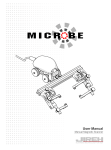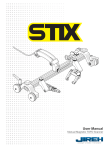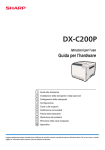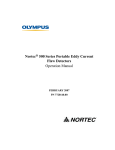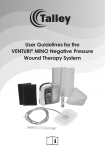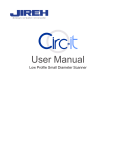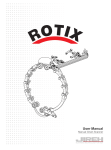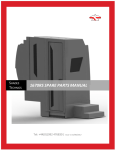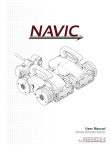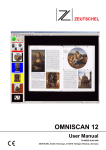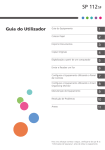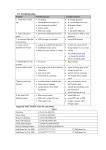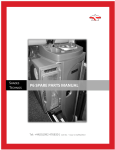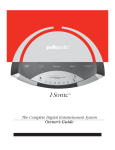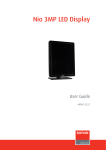Download to view PDF - Jireh Industries
Transcript
User Manual Manual Chain Frame Scanner Safety Warnings / Precautions KEEP THIS MANUAL – DO NOT LOSE THIS MANUAL IS PART OF THE ROTIX AND MUST BE RETAINED FOR THE LIFE OF THE PRODUCT. PASS ON TO SUBSEQUENT OWNERS. Ensure any amendments are incorporated with this document. DANGER! The ROTIX is designed for a specific use. Using the ROTIX outside of its intended use could cause damage to the product. Read and understand this manual before using. WARNING! MAGNETIC MATERIAL. The wheels of this device produce a magnetic field which may cause failure or permanent damage to items such as watches, memory devices, CRT monitors, medical devices or other electronics. People with pacemakers or ICD’s must stay at least 25 cm (10”) away at all times. WARNING! Do NOT operate scanner in an explosive environment. Do NOT operate scanner in the presence of volatile substances. The WEEE symbol indicates that the product must not be disposed of as unsorted municipal waste, but should be collected separately. DISTRIBUTOR: MANUFACTURER: Jireh Industries Ltd. 53158 Range Road 224 Ardrossan, Alberta, Canada T8E 2K4 Phone: (780) 922-4534 Fax: (780) 922-5766 www.jireh-industries.com PAGE i of iv CE0120 Rev 02.01 Table of Contents 1.Introduction 1.1. 1 Product information 1.1.1. 1.1.2. 1.1.3. 1.1.4. Intended use Performance specifications Operating environment Environmental Sealing 1.2. Definition of symbols 1.3.Hardware 1.4. 1.5. 1.3.1. Included tools 1.3.2. Optional tools 1.3.3. Maintenance Two Probe Chain Configuration Setup Chart Four Probe Chain Configuration Setup Chart 2. Configurations 2.1. 2.2. 2.3. 5 Two Probe Scanning Four Probe Scanning Four Probe Cantilever Scanning 3. Operation 3.1. 1 1 1 1 1 1 2 2 2 2 3 4 5 5 6 7 Setup of Rotix on a Scanning Surface 4. System Components 7 11 4.1. 4.2. Overhead Adjustable Link Crossover Wheel Block 4.3. 4.4. 4.5. 4.6. 4.7. Double Chain Mount Trailing Encoder Frame Bar Pivot Buttons Chain Components 4.8. 4.9. Ratchet Lever Slip Joint Probe Holder 4.2.1. Wheel Removal/Installation 4.7.1. Chain Connection 4.9.1. Probe Holder Setup 4.9.2. Probe Holder Adjustment 4.9.3. Probe Holder Force Adjustment PAGE ii of iv 11 11 12 12 13 13 13 14 15 15 16 16 18 18 4.9.4. Slip Joint Probe Holder Left/Right Conversion 4.10. Cable Management System 4.10.1. Zipper Tube Dovetail Mount 4.10.2. Zipper Tube Setup 4.10.3. Clamp Setup 4.11. Reduced Width Scanning Kit 4.12. Vertical Probe Holder 4.12.1. 4.12.2. 4.12.3. 4.12.4. 4.12.5. Probe Holder Setup Probe Holder Vertical Adjustment Probe Holder Transverse Adjustment Probe Holder Longitudinal Adjustment Probe Holder Left/Right Conversion 4.13. Magnetic Wheel Kit 4.14. Pre-amp Bracket 20 22 22 23 24 24 25 25 26 27 28 29 31 32 5. Troubleshooting 33 6. Spare Parts 34 6.1. Kit Components 6.1.1. Encoder Connector Style 6.2.Accessories 6.2.1. 6.2.2. 6.2.3. 6.2.4. Zipper Tube Pre-Amp Bracket Magnetic Wheel Kit Reduced Width Scanning Kit 6.3. Probe Holders 6.4. Probe Holder Components 6.5. Variable Components 6.3.1. Slip Joint Probe Holder Parts 6.3.2. Vertical Probe Holder Parts 6.4.1. Arm Style 6.4.2. Yoke Style 6.4.3. Pivot Button Style 6.5.1. Frame Bars 7. Limited Warranty 34 35 35 35 35 36 36 37 37 38 39 39 39 39 39 39 40 PAGE iii of iv CE0120 Rev 02.01 PAGE iv of iv 1. Introduction 1.1. Product information 1.1.1. Intended use The ROTIX chain scanner is a manually operated scanner which provides encoded probe positions of two or four probes. The double wheel chain components straddle the weld and fasten a scanning frame circumferentially around pipe or tubing. 1.1.2. Performance specifications Minimum Maximum Pipe/Tube range 38.1 mm (1.5 in) 965.2 mm (38.0 in) Umbilical length (Standard kit) 5 m (16.4 in) X-Axis encoder resolution 9.05 counts/mm (230.0 counts/inch) 1.1.3. Operating environment The ROTIX chain scanner is designed for use in an industrial environment that is between -20° C (-4° F) and 50° C (122° F). 1.1.4. Environmental Sealing Dust tight, water tight (not submersible). 1.2. Definition of symbols Instructions to ‘look here’ or to ‘see this part’. Denotes movement. Instructing user to carry out action in a specified direction. Indicates alignment axis. Alerts user that view has changed to a reverse angle. PAGE 1 of 41 CE0120 Rev 02.01 1.3. Hardware 1.3.1. Included tools Fig. 1 - 3 mm hex driver Fig. 2 - 3/8 in wrench The 3 mm hex driver (Fig. 1) is sufficient for all typical operations and adjustments of the ROTIX. The 3/8 in wrench (Fig. 2) is used to remove and install buttons on the probe holders. 1.3.2. Optional tools Some specialized adjustments require tools that are not included with this kit. Fig. 3 - 1.5 mm hex wrench Fig. 4 - 2 mm hex wrench Fig. 5 - 2.5 mm hex wrench Fig. 6 - 3 mm hex wrench 1.3.3. Maintenance General cleaning of components is important to keep your system working well. All components that have no wiring or cables are completely waterproof. Components can be washed with warm water, dish soap and a medium bristle brush. After washing your system, use a light oil to lubricate the slide and the adjustment screw on the buckle component (Fig. 33). Before using the scanner, ensure all connectors are free of water and moisture. NOTE: All components with wiring, cables or electrical connections are splash proof. However, these components are NOT submersible. NOTE: Never use strong solvents or abrasive materials to clean your scanner components. PAGE 2 of 41 Two Probe Chain Configuration Setup Chart MIN (in) PIPE SIZE MAX (in) MIN (mm) MAX (mm) SHORT* LONG *SHORT INCLUDES: SHORT LINK, DOVETAIL LINK, RED CATCH LINK TWO PROBE WELD FRAME CHAIN SCANNER: Setup Chart 1.4. 3.8 4.5 5.2 6.0 6.8 7.5 8.3 9.1 9.9 10.7 11.7 12.4 13.2 13.5 14.3 15.0 15.9 16.6 17.4 18.2 19.0 19.7 20.5 21.3 22.1 22.9 23.7 24.5 25.3 26.1 26.9 27.7 28.5 29.2 30.1 30.9 31.6 32.5 33.2 34.0 34.8 35.6 36.4 37.2 38.0 38.8 39.6 4.6 5.3 6.1 6.9 7.7 8.5 9.3 10.1 10.9 11.7 12.6 13.4 14.2 14.4 15.2 16.0 16.8 17.6 18.3 19.2 19.9 20.7 21.5 22.3 23.1 23.9 24.7 25.5 26.3 27.1 27.9 28.7 29.5 30.3 31.1 31.9 32.6 33.5 34.2 35.0 35.8 36.6 37.4 38.2 39.0 39.8 40.6 97 114 132 152 173 191 211 231 251 272 297 315 335 343 363 381 404 422 442 462 483 500 521 541 561 582 602 622 643 663 683 704 724 742 765 785 803 826 843 864 884 904 925 945 965 986 1006 117 135 155 175 196 216 236 257 277 297 320 340 361 366 386 406 427 447 465 488 505 526 546 566 587 607 627 648 668 688 709 729 749 770 790 810 828 851 869 889 909 930 950 970 991 1011 1031 PAGE 3 of 41 2 3 4 5 6 7 8 9 10 11 9 10 11 2 3 4 2 3 4 2 3 4 5 6 7 8 9 10 11 3 4 2 3 4 2 3 4 2 3 4 5 6 7 8 9 10 11 0 0 0 0 0 0 0 0 0 0 1 1 1 4 4 4 5 5 5 6 6 6 6 6 6 6 6 6 6 9 9 10 10 10 11 11 11 12 12 12 12 12 12 12 12 12 12 CE0120 Rev 02.01 Four Probe Chain Configuration Setup Chart MIN (in) PIPE OD RANGE MAX (in) MIN (mm) MAX (mm) SHORT* LONG *SHORT INCLUDES: SHORT LINK, DOVETAIL LINK, RED CATCH LINK FOUR PROBE WELD FRAME CHAIN SCANNER: Setup Chart 1.5. 4.4 5.1 5.8 6.6 7.4 8.2 9.0 9.8 10.6 11.4 12.3 13.1 13.9 14.9 15.7 16.5 17.3 18.0 18.9 19.7 20.4 21.2 22.0 22.8 23.6 24.4 25.1 25.9 26.8 27.6 28.4 29.2 30.0 30.8 31.6 32.4 33.1 33.9 34.7 35.5 36.3 37.1 37.9 5.2 6.0 6.8 7.6 8.4 9.2 10.0 10.8 11.6 12.4 13.3 14.1 14.9 15.9 16.7 17.5 18.3 19.1 19.9 20.7 21.5 22.3 23.0 23.8 24.6 25.4 26.2 27.0 27.9 28.6 29.5 30.2 31.0 31.8 32.6 33.4 34.2 35.0 35.8 36.6 37.4 38.2 39.0 111 129 148 168 187 207 228 248 268 289 312 332 352 378 398 419 439 458 480 499 519 539 559 579 599 619 639 659 681 701 721 741 761 782 802 822 842 862 882 902 922 942 962 133 152 172 192 212 233 253 274 294 315 338 358 378 404 424 445 465 485 506 526 545 565 585 605 625 645 666 686 708 728 748 768 788 809 829 849 869 889 909 929 950 970 990 PAGE 4 of 41 1 2 3 4 5 6 7 8 9 10 8 9 10 2 3 1 2 3 1 2 3 4 5 6 7 8 9 10 2 3 1 2 3 1 2 3 4 5 6 7 8 9 10 0 0 0 0 0 0 0 0 0 0 1 1 1 4 4 5 5 5 6 6 6 6 6 6 6 6 6 6 9 9 10 10 10 11 11 11 11 11 11 11 11 11 11 2. Configurations 2.1. Two Probe Scanning Fig. 7 - Two probe scanning 2.2. Four Probe Scanning Fig. 8 - Four probe scanning PAGE 5 of 41 CE0120 Rev 02.01 2.3. Four Probe Cantilever Scanning Fig. 9 - Four probe cantilever scanning PAGE 6 of 41 3. Operation 3.1. Setup of Rotix on a Scanning Surface 1. Determine the diameter of the pipe or tube to be scanned. Included in the ROTIX kit and in this manual, are two setup charts which indicate the number of links required based on the diameter of the pipe or tubing (Fig. 10). Refer to the appropriate chart based on the number of probes to be used when scanning. Fig. 10 - Refer to setup chart Fig. 11 - Assemble configuration 2. Assemble the appropriate configuration to the frame bar (Fig. 11). Install the wedge and probes that will be used (see Slip Joint Probe Holder on page 16). TIP: The following example is a four probe configuration for a 12” pipe diameter. PAGE 7 of 41 CE0120 Rev 02.01 Fig. 12 - Assemble configuration 3. On a flat surface, connect the appropriate number of links (see Chain Connection on page 15) as indicated on the ROTIX setup chart. Arrange the link setup so the buckle and catch link will be 180° opposite of the scanner body (Fig. 12). TIP: Place the dovetail link 2nd in the chain after the overhead adjustable link. 4. Ensure the crossover wheel brakes are locked (see Crossover Wheel Block on page 11). 5. Drape the configured assembly around pipe/tube to be inspected (Fig. 13). Ensure the scanner’s double wheel chain links straddle the weld. Fig. 13 - Place on pipe PAGE 8 of 41 13 1 Fig. 14 - Hook buckle to catch link Fig. 15 - Adjust pressure of buckle 6. Bring the buckle arm towards the catch link. Hook the buckle’s arm to the middle axle of the catch link (Fig. 14). The buckle adjustment knob (Fig. 15-1) may have to be loosened to allow arm to reach catch link (Fig. 15). Fig. 16 - Press down to lock 7. Rotate the buckle adjustment knob until the buckle’s lever can be pushed down locking the buckle in place (Fig. 16). The tightness of the ROTIX on the pipe can be adjusted using the buckle adjustment knob (Fig. 15-1). TIP: If additional clearance is required, the buckle’s ratchet lever can be pulled out and rotated to various positions (see Ratchet Lever on page 15). PAGE 9 of 41 CE0120 Rev 02.01 Fig. 17 - Configured four probe configuration 8. Route all cabling and hoses (Only encoder cable shown) to the the zipper tube (see Cable Management System on page 22). 9. Lower probe holders to the scan surface (see Slip Joint Probe Holder on page 16). 10. Release the brakes on the crossover wheel blocks to commence scanning (see Crossover Wheel Block on page 11). PAGE 10 of 41 4. System Components 4.1. Overhead Adjustable Link The overhead adjustable link provides clearance for probes and wedges. When low profile scanning is required, the ratchet lever is adjustable. Loosen the rachet handle (Fig. 18) and extend or retract the link as required. Tighten the rachet handle (Fig. 19). Fig. 18 - Loosen ratchet lever (see Ratchet Lever on page 15) Fig. 19 - Adjust link and tighten rachet lever 4.2. Crossover Wheel Block Fig. 20 - Attach to frame bar PAGE 11 of 41 Fig. 21 - Tighten wing knob CE0120 Rev 02.01 The crossover wheel block provides stability and braking to the ROTIX system. The ratchet lever located on the crossover wheel block operates the brake. Install the crossover wheel block by loosening the black wing knob and sliding the crossover wheel block’s dovetail nut onto the frame bar (Fig. 20). Tighten the black wing knob (Fig. 21). 4.2.1. Wheel Removal/Installation Tightly grip the wheel to be removed by hand. Using the supplied 3mm hex driver (Fig. 1), loosen the wheel from the axle. TIP: When the brake is engaged and the scanner is moved, this may loosen the wheels from the axle. Grip the wheel tightly and retighten the axle with the 3mm hex driver. 4.3. Fig. 22 - Wheel removal/installation Double Chain Mount Fig. 24 - Chain mount alignment Fig. 23 - Chain mount The double chain mount provides a connection point for links. Loosen the double chain mount’s dovetail jaw using the black wing knob (Fig. 23). Secure the double chain mount to the frame bar by tightening the black wing knob. (Fig. 24). PAGE 12 of 41 4.4. Trailing Encoder The spring loaded encoder wheel provides vertical travel while maintaining contact pressure to the scan surface. To install the encoder follow these steps: Fig. 25 - Attach to frame bar Fig. 26 - Tighten knob Fig. 27 - Place on scan surface 1. Loosen the encoder’s dovetail jaw and mount to the frame bar (Fig. 25). 2. Tighten the encoder knob (Fig. 26). 3. Spring tension maintains encoder contact with the scan surface (Fig. 27). 4.5. Frame Bar Frame bars (Fig. 28) are used to mount probe holders, probe positioning systems and other accessories (see Frame Bars on page 39). Frame bars are available in a variety of lengths. 4.6. Fig. 28 - Frame bar Pivot Buttons Available in a variety of shapes and sizes fitting various wedge dimensions. Use the supplied 3/8” wrench (Fig. 2) to remove and install pivot buttons (Fig. 29). Fig. 29 - Pivot buttons PAGE 13 of 41 CE0120 Rev 02.01 4.7. Chain Components The chain components are used to fasten a scanning cart circumferentially around a pipe or tubing. Fig. 30 - Short link Fig. 31 - Long link Fig. 32 - Dovetail link Fig. 33 - Buckle Fig. 34 - Catch link Fig. 35 - Overhead adjustable link PAGE 14 of 41 4.7.1. Chain Connection Fig. 36 - Pull out and twist pins Fig. 37 - Align mounting holes Fig. 38 - Release pins To connect chain components, see these following steps: 1. Pull the pins out from the wheels, twist a quarter turn latching the pins in a retracted state (Fig. 36). 2. Align the pins with the mounting holes of the component to be connected (Fig. 37). 3. Twist the pins until they unlatch and extend into the hole of the connected component (Fig. 38). 4.8. Ratchet Lever Fig. 39 - Pull ratchet handle Fig. 40 - Rotate handle Fig. 41 - Tighten handle The rachet levers are used for various locking functions on the ROTIX system. Occasionally, movement of the lever locking position is required. The lever placement can be adjusted by following these steps: 1. Pull the ratchet lever away from the base of which it is connected (Fig. 39). 2. Continue to pull while rotating the lever in the appropriate direction (Fig. 40). 3. Release the lever and utilize the new tightening position. PAGE 15 of 41 CE0120 Rev 02.01 4.9. A Slip Joint Probe Holder C B D E H F I G Fig. 42 - Slip Joint Probe Holder A B C D E F G H I Frame Bar Probe Holder Adjustment Knob Latch Swing Arm Knob Yoke Probe Holder Arm Adjustment Knob Probe Holder Arm Arm Clamp Screw Pivot Buttons 4.9.1. Probe Holder Setup To mount a UT wedge in the probe holder, follow these steps: Fig. 43 - Attach to frame bar Fig. 44 - Adjust on frame bar 1. Rotate the probe holder adjustment knob and attach probe holder to a frame bar (Fig. 43). 2. Use the probe holder adjustment knob to position the probe holder along the frame bar (Fig. 44). Fig. 45 - Adjust swing arm PAGE 16 of 41 Fig. 46 - Place pivot buttons 3. Use swing arm knob to position the swing arm (Fig. 45). TIP: The swing arm is typically used to adjust TOFD center to center distance relative to the phased array probes on a four probe configuration (Fig. 8). 4. Using the supplied 3/8” wrench (Fig. 2), place the pivot buttons as required (Fig. 46). TIP: If narrow scanning footprint is required, use pivot button holes closest to the yoke. Wedge pivoting may be impeded when closer to the yoke. Fig. 47 - Adjust probe holder arms Fig. 48 - Place wedge 5. Loosen the probe holder arm adjustment knob (Fig. 47) and remove outer probe holder arm from yoke. 6. Adjust inner probe holder arm as required to best centre the probe on the yoke’s pivot axis (Fig. 47). TIP: The probe holder yoke can accommodate many different probe and wedge sizes of varying widths. It is best to centre the wedge with the yoke’s pivot axis to reduce wedge tipping when scanning. Position the inner probe holder arm accordingly with the centre of the yoke (Fig. 47). 7. Position the wedge on the inner probe holder arm (Fig. 48). 8. Slide outer probe holder arm along the yoke pinching the wedge in place. 9. Tighten probe holder arm adjustment knob (Fig. 49). Fig. 49 - Pinch wedge with arm PAGE 17 of 41 CE0120 Rev 02.01 4.9.2. Probe Holder Adjustment To adjust the probe holder, follow these steps: 6mm approx. Fig. 50 - Lift to Latched position Fig. 51 - Lower to scanning surface 1. Ensure probe holder is in latched, upper position (Fig. 50). If the probe holder is already latched, it will only move within the slip joint adjustment range and have no spring tension. 2. Push the probe holder yoke down toward inspection surface until the wedge is approximately 6 mm (¼”) above the inspection surface (Fig. 51). Fig. 52 - Lift and press latch button Fig. 53 - Spring loaded scan position 3. Lift probe slightly and press latch button (Fig. 52) to apply spring pressure to the wedge. 4. Gently lower probe holder and wedge to the scanning surface (Fig. 53). 4.9.3. Probe Holder Force Adjustment It is possible to adjust the tension of the probe holder spring. NOTE: To perform this operation the 2 mm hex wrench (Fig. 4) and 3 mm hex wrench (Fig. 6) is required. Light Medium Heavy 1 kg 2 lb 2 kg 4 lb 3 kg 6 lb When configured correctly, these settings exert the indicated spring force on the Probe. To adjust the probe holder’s force, follow these steps: PAGE 18 of 41 NOTE: Do not perform this operation on scanning surface. Fig. 54 - Lift slightly and press Latch Fig. 55 - Unlatched position 1. Ensure the probe holder is in the upright latched position (Fig. 50). 2. Lift probe holder slightly and press the latch button (Fig. 54) to release the probe holder the full 45° degrees. 3. Insert the short arm of a 3 mm hex wrench into the 3 mm slot (Fig. 55). Fig. 56 - Insert hex wrenches Fig. 57 - Press 3 mm hex wrench down 4. Place the 2 mm hex wrench into the force adjustment screw (Fig. 56). 5. Lightly press the long arm of the 3 mm hex wrench down. Using the 2 mm hex wrench, loosen the force adjustment screw but do not remove it (Fig. 57). 6. Gently apply pressure on the long leg of the 3 mm hex wrench until the force adjustment marker lines up with the desired spring tension. While keeping the markers in line, tighten the force adjustment screw (Fig. 58). Heavy Medium Light Force Adj. Marker Fig. 58 - Choose desired tension PAGE 19 of 41 CE0120 Rev 02.01 4.9.4. Slip Joint Probe Holder Left/Right Conversion To reverse the probe holder, follow these steps: Fig. 59 - Unscrew yoke pivot screw Fig. 60 - Remove arms 1. Unscrew the yoke from the swing arm (Fig. 59). 2. Loosen the probe holder arm adjustment knob and arm clamp screw. Slide the arms from the yoke (Fig. 60). Fig. 61 - Flip yoke and reverse arms Fig. 62 - Attach arms and move buttons 3. Flip the yoke 180° and reverse the probe holder arms (Fig. 61). 4. Place the pivot buttons on the inside of the probe holder arms (Fig. 62) using a 3/8 in wrench (Fig. 2). Slide the arms onto the yoke and tighten the probe holder arm adjustment knob and the arm clamp screw. PAGE 20 of 41 Fig. 63 - Position swing arm Fig. 64 - Install yoke to swing arm 5. Loosen the swing arm knob and slide the swing arm to the opposite end of the probe holder bracket (Fig. 63) or preferred position. Tighten swing arm knob. 6. Using the 3 mm hex driver, screw the yoke pivot screw into the opposite side of the probe holder swing arm (Fig. 64). Ensure the yoke is level to avoid issues with the plunger/set screw. Fig. 65 - Reversed probe holder PAGE 21 of 41 CE0120 Rev 02.01 4.10. Cable Management System Fig. 66 - Cable management TIP: When using the zipper tube, ensure the dovetail link is placed 2nd in the chain behind the overhead adjustable link. 4.10.1. Zipper Tube Dovetail Mount To attach a zipper tube for cable management, follow these steps: Fig. 67 - Loosen and slide on PAGE 22 of 41 Fig. 68 - Tighten knob 1. Loosen the knob on the zipper tube dovetail mount. Slide the mount onto the dovetail link (Fig. 67). 2. Once centred on the dovetail link, tighten the zipper tube’s dovetail mount knob (Fig. 68). 4.10.2. Zipper Tube Setup The zipper tube option is offered in a variety of lengths and provides a means of bundling and protecting cables and hoses that run to the scanner. Fig. 69 - Insert cables and hoses Fig. 70 - Zip up to close 1. Open the zipper tube. Begin at the tube’s dovetail mount and place the cabling in the tube (Fig. 69). 2. Follow the cable placement zipping the tube closed (Fig. 70). Fig. 71 - Zip opposite end Fig. 72 - Flexibility 3. Once the cable is placed the entire length of tube, bring the zipper from the tubes opposite end, meeting at any point in the middle (Fig. 71). 4. When necessary, the two zippers may be opened to allow any cables to exit the tube anywhere between the ends (Fig. 72). PAGE 23 of 41 CE0120 Rev 02.01 4.10.3. Clamp Setup If the tube becomes disconnected from the zipper tube dovetail mount, follow these instructions to re-attach the tube and dovetail mount. 1. Loosen the clamp screw using the supplied 3 mm hex driver. 2. Slide the clamp around the tube first and then slide the tube around the outside of the zipper tube dovetail mount (Fig. 73). Align the zipper opening and the zipper tube dovetail mount opening. 3. Slide the clamp over the tube and zipper tube dovetail mount pinching the tube in between (Fig. 74). Fig. 73 - Slide tube around mount Fig. 74 - Slide clamp onto mount 4. Tighten the clamp screw (Fig. 75). Fig. 75 - Tighten clamp screw 4.11. Reduced Width Scanning Kit The encoded probe holding link houses the main encoder and provides a mounting base for probe holders. To mount/adjust the frame bar, loosen the bar adjustment knobs, insert bar, slide to desired placement, then tighten bar adjustment knobs. Fig. 76 - Reduced width scanning kit PAGE 24 of 41 4.12. Vertical Probe Holder A B C D E F G H I B Latch A Probe Holder Adjustment Knob C Vertical Adjustment Knob Pivot Buttons I C H Probe Holder Arms Yoke G Probe Holder Arm Adjustment Knob F Transverse Adjustment Screw Frame Bar E D Fig. 77 - Vertical probe holder 4.12.1. Probe Holder Setup To mount a UT wedge in the probe holder, follow these steps: Fig. 78 - Adjust on frame bar Fig. 79 - Vertical adjustment Fig. 80 - Place buttons 1. The probe holder adjustment knob allows the probe holder to be attached to a frame bar, as well as horizontal positioning on a frame bar (Fig. 78). 2. Vertical adjustment knob allows the vertical probe holder height adjustment (Fig. 79). 3. Position the pivot buttons where necessary, When narrow scanning footprint is required, use the pivot button holes closets to the yoke (Fig. 80). TIP: Probe pivoting may be impeded when closer to the yoke. PAGE 25 of 41 CE0120 Rev 02.01 Fig. 81 - Adjust inner arm Fig. 82 - Adjust outer arm Fig. 83 - Tighten arm knob 4. Position the wedge on the inner probe holder arm. TIP: The probe holder yoke can accommodate many different probe and wedge sizes of varying widths. It is best to centre the wedge with the yoke’s pivot axis. This can reduce wedge tipping when scanning. Position the inner probe holder arm accordingly (Fig. 81) using the supplied 3 mm hex driver (Fig. 1). 5. Loosen the probe holder arm adjustment knob (Fig. 82) and slide the probe holder arm along the yoke pinching the wedge in place. 6. Tighten the probe holder arm adjustment knob (Fig. 83). 4.12.2. Probe Holder Vertical Adjustment To adjust the probe holder vertically, follow these steps: approx. 6mm Fig. 84 - Latch probe holder Fig. 85 - Lower toward scan surface 1. Ensure the probe holder is in the latched, upper position. Lift the probe holder until the latch is fully exposed and snaps out to lock (Fig. 84). PAGE 26 of 41 2. Loosen the vertical adjustment knob and slide the probe holder down until the wedge is approximately 6 mm (¼ in) above inspection surface (Fig. 85). 3. Tighten the vertical adjustment knob (Fig. 85). Fig. 86 - Press latch button Fig. 87 - Lower toward scan surface 4. Lift the yoke slightly and press the latch button (Fig. 86), then slowly lower towards scanning surface to apply spring pressure to the wedge (Fig. 87). TIP: If less spring force is desired, refer to step 2 and place the wedge approximately 20 mm (¾ in) above inspection surface. 4.12.3. Probe Holder Transverse Adjustment To adjust the probe holder’s transverse angle, follow these steps: Fig. 88 - Loosen 3 mm screw Fig. 89 - Rotate and tighten Fig. 90 - Stop post locates 90° 1. Ensure the probe holder is in latched, upper position (Fig. 84). PAGE 27 of 41 CE0120 Rev 02.01 2. Using the supplied 3 mm hex driver loosen the transverse adjustment screw (Fig. 88) and rotate the yoke about the vertical shaft achieving the desired angle. 3. Tighten the transverse adjustment screw (Fig. 89). To return the transverse adjustment to neutral (90°). The probe holder must be in the latched, upper position (Fig. 84). Rotate the yoke until the stop post contacts the base of the probe holder (Fig. 90). Then tighten the transverse adjustment screw. 4.12.4. Probe Holder Longitudinal Adjustment To adjust the probe holder’s vertical angle for longitudinal scanning, follow these steps: Fig. 91 - Loosen 3 mm screw Fig. 92 - Rotate to position Fig. 93 - Line up markers 1. Ensure the probe holder is in latched, upper position (Fig. 84). 2. Using the supplied 3 mm hex driver (Fig. 1), loosen the longitudinal adjustment screw (Fig. 91). 3. Rotate the main body of the probe holder until it is at the desired angle. 4. Tighten the longitudinal adjustment screw (Fig. 92). To return the longitudinal adjustment to neutral (90°). Line up the longitudinal adjustment indicator markers (Fig. 93). PAGE 28 of 41 4.12.5. Probe Holder Left/Right Conversion To reverse the probe holder, follow these steps: NOTE: To perform this operation the 1.5 mm hex wrench (Fig. 3) is required. Fig. 94 - Unscrew yoke pivot screw Fig. 95 - Remove probe holder arms 1. Ensure the probe holder is in latched, upper position (Fig. 84). 2. Using the supplied 3 mm hex driver (Fig. 1), unscrew the yoke pivot screw and remove yoke (Fig. 94). 3. Loosen the probe holder arm adjustment knob and the arm clamp screw. Slide the probe holder arms off the yoke (Fig. 95). Fig. 96 - Flip yoke and reverse arms Fig. 97 - Attach arms & move buttons 4. Flip the yoke 180° and swap the probe holder arms (Fig. 96). 5. Place the pivot buttons on the inside of the probe holder arms (Fig. 97) using a 3/8 in wrench (Fig. 2). PAGE 29 of 41 CE0120 Rev 02.01 Fig. 98 - Screw yoke to opposite side Fig. 99 - Lower 90° stop post 6. Mount the yoke to the opposite side of the base using the supplied 3 mm hex driver (Fig. 98). TIP: Keep the yoke level with the base as to ensure no conflicts with the plunger/set screw attached to the yoke. 7. Locate the recessed M3 screw (stop post) on the bottom of the probe holder. Unscrew the stop post using a 1.5 mm hex wrench until it has cleared all obstructions. Do not remove stop post (Fig. 99). Fig. 100 - Raise opposite 90° stop post Fig. 101 - Reversed probe holder 8. Raise the stop post on the opposite side until the side of the post clearly contacts the 90° stop point on the probe holder’s base (Fig. 100). PAGE 30 of 41 4.13. Magnetic Wheel Kit WARNING! MAGNETIC MATERIAL. The magnetic wheel kit produce a magnetic field which may cause failure or permanent damage to items such as watches, memory devices, CRT monitors, medical devices or other electronics. People with pacemakers or ICD’s must stay at least 25 cm (10 in) away. When the use of a chain scanner is not appropriate, the magnetic wheel kit (Fig. 102) can be used to replace the urethane wheels on a ROTIX scanner body. Two sets of the magnetic wheel kits can also be used on the scanner body to double the magnetic force. To install or remove wheels (see Crossover Wheel Block on page 11). NOTE: Do not use the magnetic wheels in conjunction with a chain assembly. Fig. 102 - Magnetic wheel kit NOTE: Magnetic wheels may lose their magnetic properties if heated above 175°F (80° C). PAGE 31 of 41 CE0120 Rev 02.01 4.14. Pre-amp Bracket The pre-amp bracket mounts to any dovetail groove to hold a pre-amp. Compatible with most standard pre-amps, use the adjustable screw mounting channel on the bottom of the bracket to attach a pre-amp. The pre-amp bracket may also be ordered with velcro straps which are used to hold the pre-amp. 1 Fig. 103 - Insert velcro straps 3 2 Fig. 104 - Place pre-amp and wrap velcro PAGE 32 of 41 Fig. 105 - Mount bracket on a frame bar 5. Troubleshooting Problem 1. Chain is too loose/tight 2. Insufficient probe contact. Possible Cause Solution Incorrect number or combination of links for proper scanner configuration. Refer to the ROTIX setup chart (see Two Probe Buckle is incorrectly setup. Adjust tightness of buckle (see Operation 4.1. Scanner not set properly. Reconfigure the scanner as per instructions Chain Configuration Setup Chart on page 3) or (see Four Probe Chain Configuration Setup Chart on page 4) for required number of links for the diameter of pipe/tube that is to be scanned. Ensure the correct outer diameter measurement of the pipe/tube. Reset the scanner with the correct number of links. Section 6 on page 13) (see Probe Holder Adjustment on page 18) PAGE 33 of 41 CE0120 Rev 02.01 6. Spare Parts To order accessories or replacement parts for your ROTIX system. (contact Jireh Industries Ltd. on page i) NOTE: These drawings are for parts order. This is not a list of kit contents. 6.1. Kit Components 14 13 15 13 14 12 10 11 9 8 5 6 4 7 3 1 2 BOM ID 1 2 3 4 5 6 7 Part # CES036 CES034 CES033 CES040 CES035 CES042 CEA011 Description Buckle Long Link Short Link Dovetail Link Catch Link Crossover Wheel Block Rotix Case BOM ID 8 9 10 11 12 13 14 15 Part # Description CES032 Double Chain Mount BGS053-X-05 Trailing Encoder (see 6.1.1.) BG0038-X Frame Bar (see 6.5.1.) CES031 Overhead Adjustable Link PHG014 2 Probe Spare Parts Kit CMG007 Irrigation Kit EA414 3 mm Hex Driver EA470 3/8 in Wrench Fig. 106 - Rotix parts PAGE 34 of 41 6.1.1. Encoder Connector Style Connector Type Company/Instrument Connector Type Company/Instrument B Olympus - OmniScan MX / Zetec - ZIRCON, TOPAZ G Sonotron - Isonic C Olympus - Focus LT / Zetec Z-Scan M GE - USM Vision D Olympus - OmniScan MX2, OmniScan SX U Sonatest - VEO, PRISMA F TD - Focus Scan, Handy Scan, Pocket Scan Fig. 107 - Umbilical style NOTE: Additional encoder connector styles available. (contact Jireh Industries Ltd. on page i) 6.2. Accessories 6.2.1. Zipper Tube Part # Description CES044-04.5 Zipper Tube (4.5 m length) CES044-09.5 Zipper Tube (9.5 m length) Fig. 108 - Zipper Tubes 6.2.2. Pre-Amp Bracket Part # CES029 CES029-V Description Pre-Amp Bracket Pre-Amp Bracket with Velcro Fig. 109 - Pre-amp bracket PAGE 35 of 41 CE0120 Rev 02.01 6.2.3. Magnetic Wheel Kit Part # BTG014 Description Magnetic Wheel Kit Fig. 110 - Magnetic wheel kit 6.2.4. Reduced Width Scanning Kit Part # Description CEG018-W-XX-Y-Z Reduced Width Scanning Kit, W - See 6.1.1, XX - See 6.4.3, Y - See 6.4.1, Z - See 6.4.2 Fig. 111 - Reduced width scanning kit PAGE 36 of 41 6.3. Probe Holders 6.3.1. Slip Joint Probe Holder Parts 3 1 2 4 5 6 7 8 BOM ID 1 2 3 4 5 6 7 8 Part # PHS022 MD050-010 PH0104 PH0100 PH0082 SEE 6.4.2 SEE 6.4.1 PH0011-X Description Slip Joint Probe Holder Subassembly Arm Clamp Screw, SHCS, M4x0.7 X 10 mm, SST Swing Arm Knob Swing Arm Probe Holder Arm Adjustment Knob Yoke Style Arm Style Pivot Button Style (see 6.4.3) Fig. 112 - Slip joint probe holder parts PAGE 37 of 41 CE0120 Rev 02.01 6.3.2. Vertical Probe Holder Parts 1 6 2 5 4 3 BOM ID 1 2 3 4 5 6 Part # PHS028 PH0082 SEE 6.4.1 PH0011-X SEE 6.4.2 MD050-010 Description Vertical Probe Holder Subassembly Probe Holder Arm Adjustment Knob Arm Style Pivot Button Style (see 6.4.3) Yoke Style Arm Clamp Screw, SHCS, M4x0.7 X 10 mm, SST Fig. 113 - Vertical probe holder PAGE 38 of 41 6.4. Probe Holder Components 6.4.1. Arm Style Arm Style Part # A Standard PH0090 B Short PH0089 C Long PH0099 D Standard, Drop PH0093 E Short, Drop PH0092 Arm Style Part # F Long, Drop PH0094 G Standard, Extra-Drop PH0096 H Short, Extra-Drop PH0095 Fig. 114 - Probe holder arm selection 6.4.2. Yoke Style Yoke Style S Standard Part # Length Yoke Style W PHS017 6.27 cm (2.470 in) Wide Part # Length PHS027 7.78 cm (3.064 in) Fig. 115 - Probe holder yoke selection 6.4.3. Pivot Button Style Pivot Hole Size Wedge Type 01 8.0 mm (0.315 in) Olympus PA 02 5.0 mm (0.197 in) 03 2.7 mm (0.106 in) 04 9.5 mm (0.375 in) Pivot Hole Size Wedge Type 06 3.0 mm (0.118 in) - Olympus TOFD 07 2.3 mm (0.090 in) Sonatest DAAH PA 08 Conical Head - 09 5 mm (0.197 in) Internal Zetec PA/TOFD - - Fig. 116 - Probe holder button selection NOTE: Additional probe holder pivot button types available. (contact Jireh Industries Ltd. on page i) 6.5. Variable Components 6.5.1. Frame Bars Part # Length Part # Length BG0038-05 5 cm (1.969 in) BG0038-35 35 cm (13.780 in) BG0038-10 10 cm (3.937 in) BG0038-40 40 cm (15.748 in) BG0038-15 15 cm (5.906 in) BG0038-45 45 cm (17.717 in) BG0038-20 20 cm (7.874 in) BG0038-50 50 cm (19.685 in) BG0038-25 25 cm (9.843 in) BG0038-55 55 cm (21.654 in) BG0038-30 30 cm (11.811 in) Fig. 117 - Frame bar selection PAGE 39 of 41 CE0120 Rev 02.01 7. Limited Warranty WARRANTY COVERAGE Jireh Industries warranty obligations are limited to the terms set forth below: Jireh Industries Ltd. (“Jireh”) warrants this hardware product against defects in materials and workmanship for a period of THREE (3) YEARS from the original date of purchase. If a defect exists, at its option Jireh will (1) repair the product at no charge, using new or refurbished replacement parts, (2) exchange the product with a product that is new or which has been manufactured from new or serviceable used parts and is at least functionally equivalent to the original product, or (3) refund the purchase price of the product. A replacement product/part assumes the remaining warranty of the original product or ninety (90) days from the date of replacement or repair, whichever provides longer coverage for you. When a product or part is exchanged, any replacement item becomes your property and the replaced item becomes Jireh’s property. When a refund is given, your product becomes Jireh’s property. OBTAINING WARRANTY SERVICE To utilize Jireh’s warranty service you must ship the product, at your expense, to and from Jireh Industries. Before you deliver your product for warranty service you must phone Jireh and obtain an RMA number. This number will be used to process and track your product. Jireh is not responsible for any damage incurred during transit. EXCLUSIONS AND LIMITATIONS This Limited Warranty applies only to hardware products manufactured by or for Jireh Industries. This warranty does not apply: (a) to damage caused by accident, abuse, misuse, misapplication, or non-Jireh products; (b) to damage caused by service (including upgrades and expansions) performed by anyone who is not an Jireh Authorized Service Provider; (c) to a product or a part that has been modified without the written permission of Jireh. Jireh Industries Ltd. 53158 Range Rd 224 Ardrossan AB T8E 2K4 Canada PH 780-922-4534 Fx 780-922-5766 www.jireh-industries.com PAGE 40 of 41 All brands are trademarks or registered trademarks of their respective owners and third party entities. Changes or modifications to this unit or accessories, not expressly approved by the party responsible for compliance could void the user’s authority to operate the equipment. All specifications are subject to change without notice. © 2014 Jireh Industries Ltd. PAGE 41 of 41 CE0120 Rev 02.01 Jireh Industries Ltd. 53158 Range Road 224 Ardrossan, Alberta Canada T8E 2K4 780-922-4534 jireh-industries.com















































